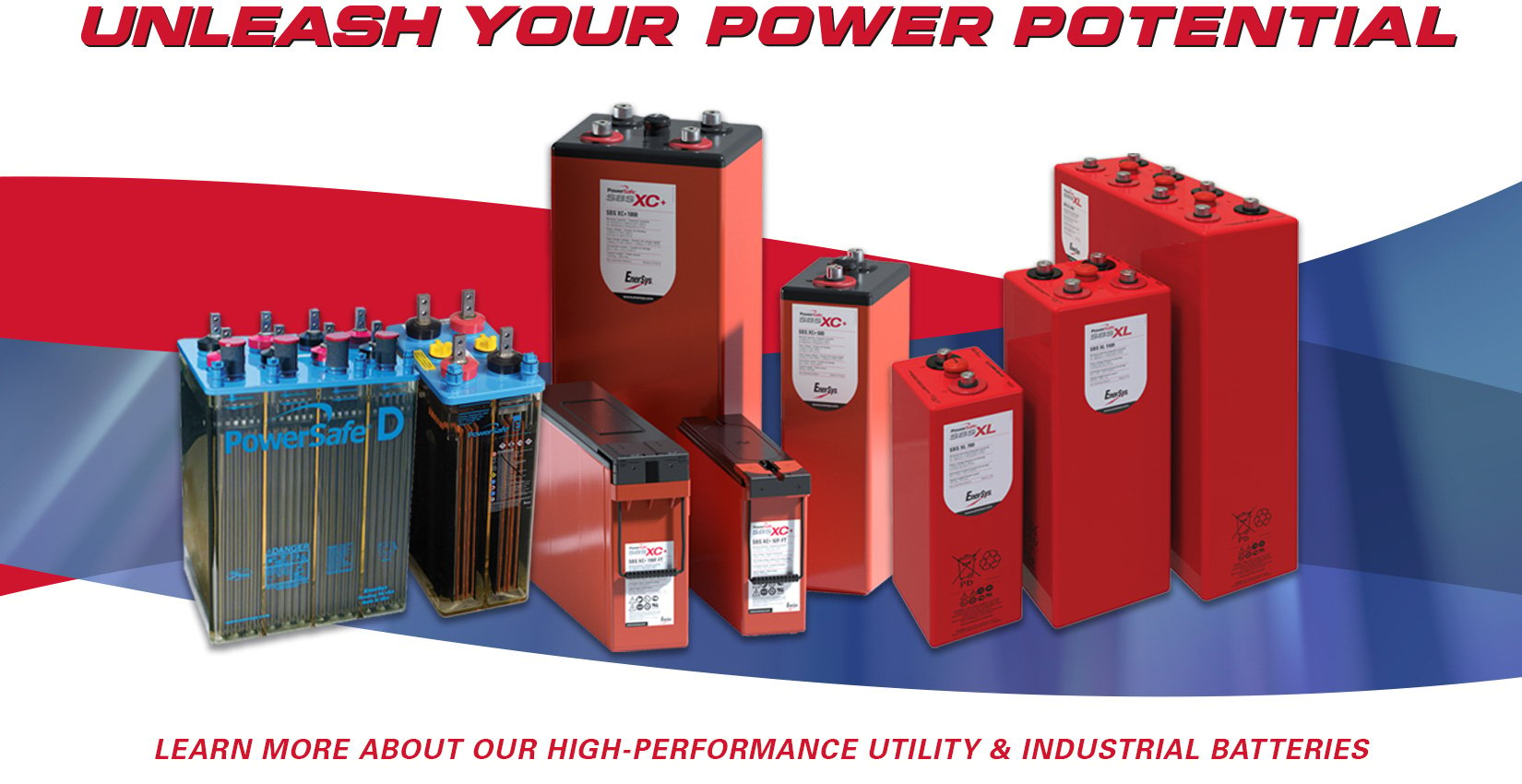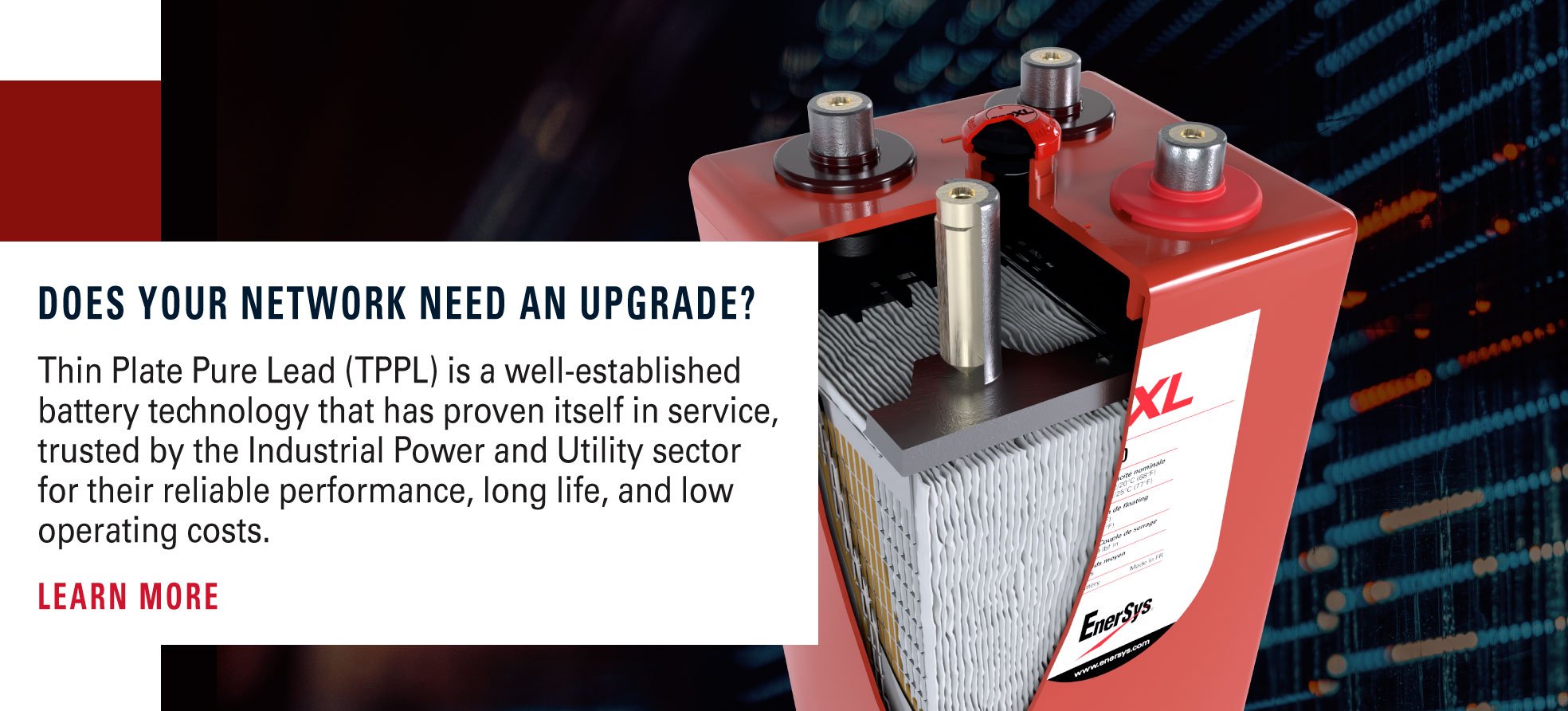Battery technology has evolved over the years, and industrial and utility organizations have many options for their energy storage requirements for backup power. This e-guide explains how proven lead-acid technologies, such as vented lead-acid (VLA) or valve-regulated lead-acid (VRLA) batteries, have undergone refinement to provide end-users with incremental performance gains that can answer their operational needs. These batteries are more than a match for alternative battery chemistries that are sometimes unproven at scale.
Lead-acid batteries are one of the oldest and most established types of batteries used in the industrial and utilities sectors. They represent a tried and trusted solution across multiple applications – providing backup for uninterruptible power supplies, storing energy in off-grid systems, and underpinning a broad range of industrial tasks on the factory floor. In short, lead-acid batteries are a reliable, cost-effective and well-understood technology, which also supports sustainability initiatives through extremely high levels of recyclability at the end of life.
Yet the go-to position for lead-acid batteries in industrial and utility markets cannot be taken for granted. Therefore, manufacturers of such battery types invest heavily in research and development to ensure refinement of their solutions. Consequently, industrial and utility organizations benefit from performance enhancement in areas such as size, power density, charging capacity and reduced maintenance costs. This activity makes advanced lead-acid batteries more than a match for alternative battery chemistries that have come to the market more recently.
OUTLINING THE DIFFERENT TYPES OF LEAD-ACID BATTERIES
So, what does the evolution of lead-acid batteries look like at a practical level? How has refinement enhanced performance over time, and what does that mean for industrial and utility organizations that continue to place their trust in such solutions?
Let us answer those questions by recognizing the distinct types of lead-acid batteries. Conventional vented lead-acid (VLA) or valve-regulated lead-acid (VRLA) batteries are mainly used in industrial and utility sectors because they are known for their reliability, relatively low cost, and ability to deliver high surge currents.
Of the two design types, VLA (flooded) batteries have been the preferred choice, particularly in North America – though this is gradually changing. Within Europe, the market is a lot more driven by VRLA batteries. In particular, distribution network operators and transmission systems operators would typically favor VRLA, with Planté (a type of flooded battery) and NiCd chemistries also entering the mix.
MISCONCEPTIONS THAT CHALLENGE VRLA ADOPTION
There are several rationales why a purchaser might choose to select VLA (flooded) batteries:
Familiarity breeds reliability
Purchasers who are accustomed to VLA (flooded) batteries may find comfort in their familiarity, knowing how these batteries have performed in various conditions over years of use. This user experience can translate into a sense of reliability, providing peace of mind in their operational continuity.
Upfront cost
Flood batteries generally have a lower upfront cost compared to VRLA batteries. This initial cost advantage can be significant for purchasers, especially those on a tight budget.
No performance incentive
In some cases, VLA (flooded) batteries may still meet the performance requirements of the application adequately. Therefore, there may be little to no incentive in switching to VRLA batteries.
Maintenance considerations
While VRLA batteries do not need the regular watering that VLA (flooded) batteries require, some end users may have the ability to perform maintenance in-house and want to be in more control of the process.
Environmental concerns
Some purchasers may perceive that VLA (flooded) batteries are easier to recycle or more environmentally friendly than their VRLA counterparts because of their simple construction.
While it is understandable that purchasers may have their reasons for selecting VLA (flooded) batteries, it is important to highlight the advancements in VRLA batteries that address these misconceptions and offer additional benefits that may make them a more appealing choice.
ADVANCEMENTS IN VRLA TECHNOLOGY
VRLA battery technology has evolved over the years, offering improvements in performance, reliability, and safety compared to VLA (flooded) types. Advancements in materials, manufacturing processes, and design, have led to the increased adoption of VRLA batteries in industrial and utility applications.
The introduction of thin plate pure lead (TPPL) technology represents a notable advancement within the VRLA battery category. TPPL batteries employ thin plates made of pure lead, allowing for more plates and a larger reactive surface area, which lowers internal resistance and energy losses, resulting in a more efficient and durable battery design. Compared to traditional lead-calcium based VRLA batteries, TPPL batteries offer several advantages including higher energy densities, improved performance at temperature extremes, faster charging rates and higher current delivery with lower voltage drop, reduced maintenance requirements, and enhanced cycle life.
Let us investigate these advancements in more detail.

Improved energy density
Advances in TPPL battery design and manufacturing have led to improvements in energy density compared to other VRLA technologies. With the global transition to sustainable energy, the utility and industrial sectors face the challenge of energy security. Wind and solar farms are intermittent forms of electricity generation, causing grid instability which can only be overcome by energy storage. Instead of batteries handling autonomies of 8 – 12 hours, autonomies of up to 72 hours may be needed, which calls for three times more storage capacity. While industrial and utility companies want to increase the capacity of their battery storage system, access to increased physical space may be an issue, especially when these installations are situated in urban locations. In scenarios such as this, being able to store more energy in a smaller footprint makes TPPL technology an attractive alternative to other VRLA technologies. PowerSafe® SBS XL 2V batteries, which are specifically designed for stable grid float applications, can fulfil this threefold storage capacity requirement in the same space.
Optimized performance at extreme temperatures
Temperature swings must also be considered, as there can be significant differences between freezing winters and severe heat in summers in various installations around the world. Although these fluctuations will impact storage capacity and autonomy, operating over the specified temperature will shorten the operational lifespan of these batteries, increasing costs because they will need to be replaced more frequently.
Compared to conventional lead-calcium based VRLA batteries, the advanced manufacturing platform of TPPL batteries enables them to operate effectively over a wider range of temperatures without significant loss of capacity or performance degradation. This makes them suitable for use in harsh environmental conditions commonly encountered in industrial and utility settings. PowerSafe® SBS XL 2V batteries, for instance, have a design life of up to 20 years.
COMPARED TO TRADITIONAL LEAD-CALCIUM BASED VRLA BATTERIES, TPPL BATTERIES OFFER SEVERAL ADVANTAGES INCLUDING HIGHER ENERGY DENSITIES, IMPROVED PERFORMANCE AT TEMPERATURE EXTREMES, FASTER CHARGING RATES AND HIGHER CURRENT DELIVERY WITH LOWER VOLTAGE DROP, REDUCED MAINTENANCE REQUIREMENTS, AND ENHANCED CYCLE LIFE.
Fast charging rates
With the rising adoption of electricity, the industrial and utility sectors require support for potential rolling blackouts, necessitating batteries with fast charging cycles. TPPL batteries can accept higher charging rates compared to lead-calcium batteries. This allows for faster charging times, reducing downtime and improving overall efficiency in applications where rapid energy replenishment is crucial resulting in lower energy being used. These factors, in combination, have potential carbon reduction benefits over the long term.
Reduced maintenance requirements
Industrial and utility facilities can be in remote rural areas, requiring long travel times for engineers. Having to schedule a truck-roll for an engineer to perform maintenance work may come at a high cost. It may also divert the maintenance engineer’s attention away from more important duties. Choosing a low-maintenance battery option is preferable over VLA (flooded) batteries, which require frequent electrolyte top-ups.
Advanced TPPL batteries require almost no maintenance when compared to standard lead-calcium batteries. The use of absorbent glass mat (AGM) technology minimizes the requirement for electrolyte maintenance, such as topping up with deionized water (watering), while also reducing the possibility of electrolyte leakage or spillage. This leads to lower operational expenses, less human interaction by maintenance personnel and fewer truck rolls, and increased reliability and safety for end users.
Enhanced cycle life
TPPL batteries, like the PowerSafe® SBS XC+ batteries, offer longer cycle life compared to traditional lead-VRLA batteries. Through innovations in plate design, electrolyte composition, and manufacturing processes, TPPL batteries can withstand a higher number of charge-discharge cycles without significant degradation in performance. This makes them ideal for applications requiring frequent cycling and deep discharges, such as renewable energy storage and grid stabilization.
Integration of advanced monitoring and management systems
TPPL batteries can be seamlessly integrated with advanced monitoring and management systems, allowing for real-time monitoring of battery health, performance, and state of charge. This enables proactive maintenance scheduling, optimized charging strategies, and improved system reliability, ensuring uninterrupted operation in critical industrial and utility applications.
EnerSys offers a wide selection of battery monitoring and performance optimization solutions, which the company can install and maintain. A proprietary battery monitoring system has been developed, and is available on certain products with others soon to follow.

SUPPORTING EVIDENCE TO CHANGE TO VRLA/TPPL BATTERIES
Revisiting the previous section where the rationales for why businesses chose VLA (flooded) batteries were discussed, let us look at the evidence supporting the transition to VRLA batteries, particularly to TPPL types.
Unfamiliarity undermines reliability
VLA (flooded) batteries may instill a sense of reliability due to years of use and understanding of their performance in diverse conditions. Yet opting for VRLA batteries can offer distinct advantages. Transitioning to VRLA batteries opens avenues for enhanced reliability, operational efficiency, and long-term cost savings, thereby challenging the notion that familiarity equates to reliability.
Long-term cost-effectiveness
Despite higher upfront investment, VRLA batteries often offer lower total cost of ownership due to their extended service life and reduced maintenance requirements compared to VLA (flooded) batteries, resulting in potential savings over the lifespan of the battery system.
ENERSYS HAS BEEN AT THE FOREFRONT OF PUSHING TECHNOLOGICAL ADVANCEMENTS IN TPPL BATTERY TECHNOLOGY, DRIVING INNOVATION IN ENERGY STORAGE SOLUTIONS FOR VARIOUS INDUSTRIES.
Enhanced performance potential
VLA (flooded) batteries often meet current performance requirements adequately. However, transitioning to VRLA batteries can unlock the potential for enhanced performance in the future. With advancements in technology, TPPL batteries offer improved energy density, faster charging capabilities, and greater reliability, providing a pathway to meet evolving application needs.
Streamlined maintenance benefits
VRLA batteries require less frequent maintenance compared to VLA (flooded) batteries, so purchasers can benefit from streamlined maintenance. With fewer maintenance tasks such as watering and corrosion checks, personnel can allocate their time more efficiently to other critical tasks, improving overall operational efficiency.
Environmental action through innovation
Recognizing the environmental concerns associated with battery technologies, purchasers can view the adoption of VRLA batteries as a step towards environmental stewardship through innovation. VLA (flooded) batteries may seem simpler to recycle, but VRLA batteries offer opportunities for advanced recycling techniques and materials recovery, contributing to a more sustainable approach to battery disposal and resource conservation
CONCLUSION
Overall, the progress of VRLA battery technology and the introduction of TPPL batteries have contributed to the evolution of energy storage solutions, providing users with more efficient, reliable, and environmentally friendly options. EnerSys has been at the forefront of pushing technological advancements in TPPL battery technology, driving innovation in energy storage solutions for various industries. The company employs advanced manufacturing techniques to produce high-quality batteries efficiently. Its state-of-the-art facilities utilize automation, robotics, and quality control processes to ensure consistency and reliability in battery production. For more information on high-performance utility and industrial batteries by EnerSys, visit EnerSys.com.

